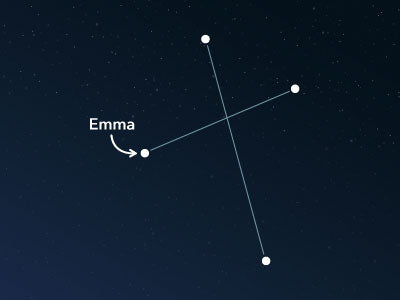The constellation Crux
Caractéristiques
- Nom latin
- Crux
- Hémisphère
- Hémisphère sud
- Visibilité
- All year round
- Région
- 68 deg²
- Étoile la plus brillante
- Acrux (HIP number 60718)
- Spécialités
- Open star clusters, dark nebula

The Crux is commonly known as Southern Cross and is a small yet conspicuous constellation. It is particularly well-known in the southern hemisphere and today adorns the flags of some countries, including New Zealand and Brazil. There are only a few deep-sky objects to observe in its area.
Hemisphere, visibility, and area
The constellation of the Crux is located, as the name suggests, in the southern sky. Due to this, it can be observed from all locations south of the equator. In the northern hemisphere, it is only visible up to the 26th latitude. This corresponds to regions such as Miami in the US or the north of Taiwan.
Up to about 35 degrees south latitude, the constellation is circumpolar, meaning it can be seen in the night sky all year round. 35° S corresponds to places like Sydney in Australia. In more northern regions, it is visible from December to March.
It is the smallest constellation compared to all other 88 constellations. Its area measures only about 69 square degrees. However, it can be easily found in the sky.
The four main stars form a classic cross in most visualizations. The shape and the brightness of the stars are very striking. All four stars shine brightly in the night sky, with Acrux (Latin: α Crucis, Alpha Crucis) being the brightest star in the Crux with an apparent magnitude of roughly 0.77. It is a triple star whose three stars can be resolved individually in a telescope. They appear as conspicuously white shining stars. The distance of this multiple-star system from the solar system is about 320 light-years.
The Crux has only two neighbors that border it directly. To the north is the Centaurus, and to the south lies the Musca.
Specialties in the constellation
There are several open star clusters and a dark nebula in the area of the Crux constellation that can be observed well.
One interesting open star cluster is NGC 4755. Due to its differently shining stars, the British astronomer John Herschel gave it the proper name Jewel Box. Its apparent magnitude is about 4.2, and its distance is approximately 5,000 to 7,000 light-years from earth. Through binoculars or a telescope, various orange-red and bluish-shimmering stars can be seen. NGC 4755 is located slightly southwest of the star Mimosa.
On the border between the constellations Centaurus and Musca, there is a dark nebula called the Coal Sack. It is the most famous dark cloud in the night sky. Its distance is estimated to be around 500 to 600 light-years. It is very noticeable because it absorbs the light of the stars behind it, creating a "hole" amid the star-rich Milky Way. Exciting structures can already be seen through binoculars.
History
In ancient Greece, the constellation was initially assigned to the Centaurus. At that time, it could still be observed from the Mediterranean region. However, over the centuries, due to the precession of the earth's movement, the constellation shifted further south until it could no longer be seen from southern Europe.
It wasn't until the 16th century, when Portuguese seafarers regularly sailed through the waters of the South Atlantic on their lucrative spice trade with India, that they rediscovered the star constellation. They took the dangerous route around the southern tip of Africa and up through the Indian Ocean to India, always orienting themselves by the stars. The constellation Crux was particularly helpful to them as it points directly towards the South Celestial Pole.
The spice trade flourished, and the Medici family from Florence eventually became involved. Consequently, family members also traveled on the fleet of ships. One was Andrea Corsali, who described the beauty of the Crux in a letter to his employer.
As a result of the poetic interpretation of the constellation, it became very popular in Europe. In 1589, the Dutch astronomer Peter Plancius finally included the constellation in his celestial globe under the name Crux, which is still in use today.
PubliéLire d'autres articles intéressants

An overview of all 88 constellations
Learn more about all 88 constellations and read interesting information about the mythology, visibility, and features.

Application Planétarium
Découvrez le ciel nocturne avec notre application de planétarium !
Disponible pour iOS et Android.

Nommez une étoile dans la constellation Southern Cross
Name a star in a constellation and create something that lasts for eternity.